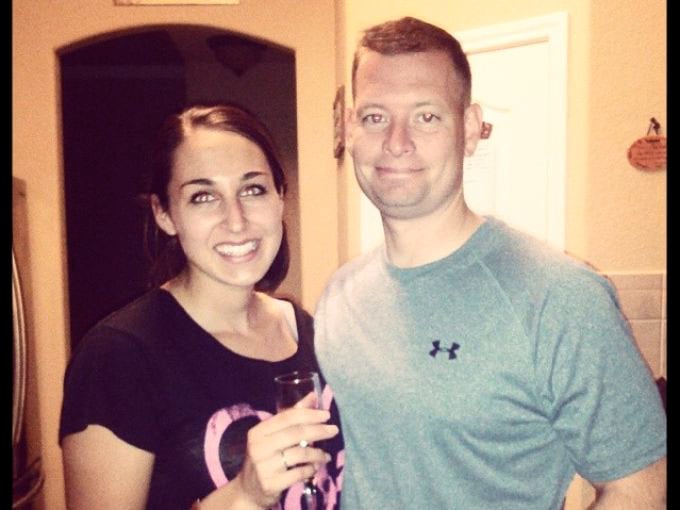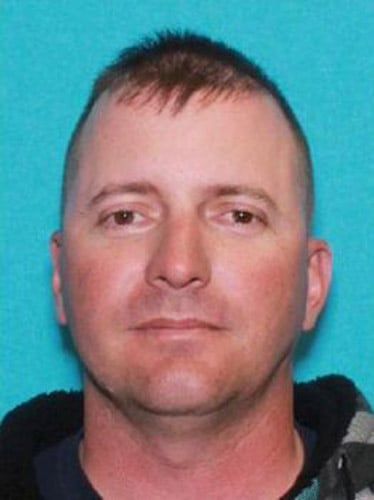When gunshots interrupted their staff meeting, Sgt. George Long didn't hesitate to follow his NCO's lead.
"I didn't really know what the situation was, but I saw my battle buddy potentially going into danger," Long said. "It wasn't a conscious decision. I just knew what I had to do."
Long's battle buddy was Sgt. 1st Class Danny Ferguson, one of three soldiers killed April 2, 2014, when Spc. Ivan Lopez-Lopez went on a deadly shooting spree on Fort Hood, Texas.

Facebook photo of Sgt. First Class Danny Ferguson, who was killed in the 2014 Fort Hood shooting rampage, and his fiance Kristen Haley, who says he was trying to block the gunman's path to a room packed with military personnel.
Photo Credit: Kristen Haley via Facebook
At the sound of the first shots, Ferguson rushed to shut the door to the meeting room. Long followed closely behind.
"When he yelled out, 'active shooter,' I still didn't really believe it," Long said. "But when he got up for the door, I just knew I had to back him up."
For his actions on that day, Long will receive the Soldier's Medal, which is awarded to service members who perform heroic acts in non-combat situations.
Long, 29, said he is humbled to be recognized.
"In my view, the main hero that day was Sgt. 1st Class Ferguson," he said. "I was just trying to back him up."
Long, an intelligence analyst who is now assigned to the 18th Field Artillery Brigade, will receive the medal during a ceremony in May at Fort Bragg, North Carolina.
A date for the ceremony has not been finalized.
On April 2, 2014, Long, Ferguson and about a dozen others from the 4th Sustainment Brigade's 49th Movement Control Battalion gathered for a meeting with the battalion executive officer. It was about 4 p.m.
"A few minutes after [the meeting] started is when Spc. Lopez came in the building," Long said.
The soldiers in the meeting were crammed into a small conference room. There was a table in the middle, and chairs lined the walls.
Long was sitting directly across from Ferguson. The men were near the end of the table, close to the exits, Long said.
"The meeting had just started when we heard a noise from the room behind where Sgt. Ferguson was sitting," Long said. "It sounded like a loud banging, but after a few seconds, Sgt. Ferguson said it was an active shooter. He stood up, and everyone hit the ground."
Some of the soldiers in the room escaped through a different exit, while others were trapped and could only seek cover on the floor, Long said.
Ferguson rushed to the open door.
"He hit the door first and got it closed," Long said.
Long said he couldn't see the shooter, but others in the room later told him they saw Ferguson push the shooter back before slamming the door shut.
Long rushed to the door, just behind Ferguson.
"I grabbed the door handle and weighted myself to the right side of the door," he said.
Lopez-Lopez fired through the door, hitting Ferguson.

This undated image provided by the Texas Department of Public Safety shows Army Spc. Ivan Lopez-Lopez. Authorities said he killed three people and wounded 16 others in a shooting at Fort Hood, Texas, on April 2, 2014, before killing himself.
Photo Credit: AP Photo/Texas Department of Public Safety
Long said they later found three bullet holes in the door.
Long called out that Ferguson had been hit, and someone low-crawled across the room to pull Ferguson to safety.
Meanwhile, Spc. Isiah Hubbard picked up a table and wedged it against the door, Long said.
The soldiers in the room worked frantically to save Ferguson, Long said. They gave him CPR and tried to bind his wounds, he said. Ferguson did not regain consciousness.
When the shooting stopped, four soldiers, including Lopez-Lopez, were dead. A dozen others were wounded.
A subsequent investigation found Lopez-Lopez opened fire after an argument with his unit's personnel section. He then left and drove away, shooting at times from his car. The three soldiers who were killed were gunned down in separate locations.
Lopez-Lopez killed himself after he was confronted by a military police officer.
Killed that day were Ferguson, Sgt. Timothy Owens and Staff Sgt. Carlos Lazaney-Rodriguez.
The shooting was the second such incident on Fort Hood in recent years. In 2009, 13 people were killed by then-Maj. Nidal Hasan, who has said he was angry about being deployed to Afghanistan and wanted to protect Islamic and Taliban leaders from U.S. troops.
Ferguson was "a really good leader," Long said.
"He was laid back but very professional," he said. "He always looked out for his soldiers, especially the lower enlisted we had."
Long recounted one lunch outing where he, Ferguson and several other soldiers were seated at the table, with Ferguson sitting at the head.
"Somebody in the unit said, 'you know, this is like the dad sitting at the end of the table,' and that's what it was like," Long said, choking back tears. "He was a mentor to all of us."
Long, who joined the Army in 2011, deployed to Afghanistan with Ferguson and worked directly for him after they returned to Fort Hood.
He credits Ferguson with saving his life.
"If he hadn't been there, I probably would've gotten shot and the shooter would have gotten access to the room," Long said. "You don't think when you're in the middle of a meeting that the person next to you would stand up and lay down their life for you. He was the kind of guy who was willing to do that. He lived by the values we hold sacred in the Army."
Michelle Tan is the editor of Army Times and Air Force Times. She has covered the military for Military Times since 2005, and has embedded with U.S. troops in Iraq, Afghanistan, Kuwait, Haiti, Gabon and the Horn of Africa.




